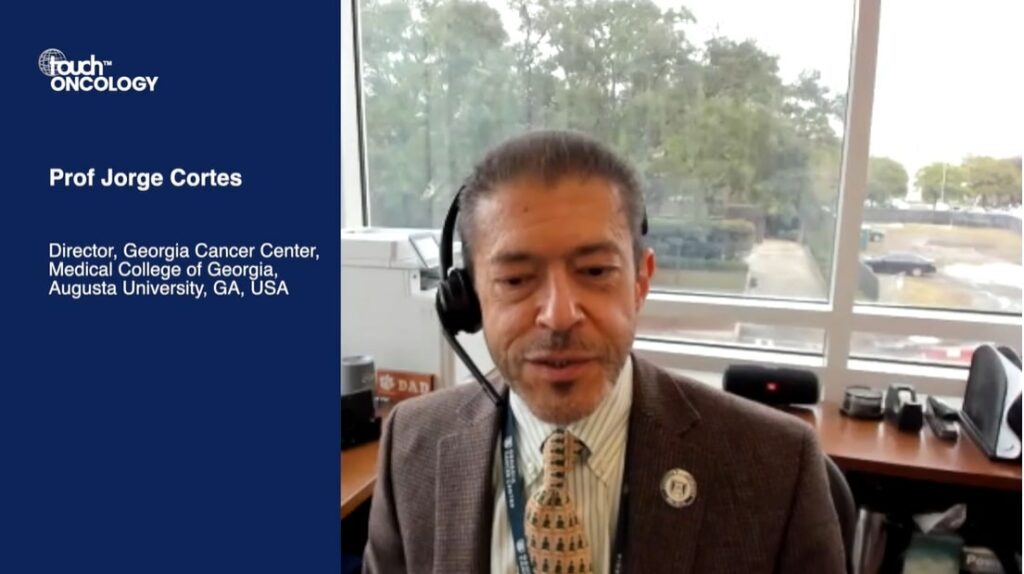Frontline treatment with azacitidine plus venetoclax (AZA/VEN) significantly improved remission rates and survival duration for older, frail and high-risk patients with acute myeloid leukaemia (AML) in the pivotal VIALE-A trial.1 The combination is approved for use in this setting,2 but longer-term survival remains suboptimal.3 At ASH 2022 in New Orleans, Louisiana, several studies aimed to improve outcomes for challenging patient populations by combining novel agents with an AZA/VEN backbone. Prof. Jorge Cortes provided an overview of these and other studies he found particularly interesting.
A phase I/II trial of a triplet with magrolimab plus AZA/VEN showed encouraging complete response rates in newly diagnosed, chemotherapy-ineligible, high-risk patients (n=41).4 Magrolimab is an anti-CD47 monoclonal antibody that inhibits CD47 thereby blocking the CD47 antiphagocytic ‘don’t eat me’ signal. It previously showed modest activity as a single agent.5 “Very importantly,” said Prof. Cortes, “it did have activity in patients that have TP53 mutation, which is an area of great need.” TP53 mutations are associated with high risk in AML, and individuals with TP53-mutated disease have poor outcomes with current standard therapies.6 The overall response rate (ORR) in 27 patients with TP53 mutation was 74% versus 93% for 14 patients with wild-type TP53. Safety analyses showed 24% of patients with grade ≥3 anaemia. A phase 3 study is currently underway in newly diagnosed patients who are ineligible for intensive chemotherapy (NCT05079230).
Another phase I/II trial presented at the meeting evaluated an AZA/VEN backbone combined with the CD123-targeted antibody–drug conjugate pivekimab sunirine in patients with relapsed or refractory (R/R) AML.7 “This is attractive because it’s a completely different mechanism of action,” said Prof. Cortes, noting that the drug has a very novel payload. Upon binding to CD123, the drug’s indolinobenzodiazepine pseudodimer payload induces single stand breaks in tumour DNA. Data from 61 evaluable patients in the higher intensity cohort showed an ORR of 51% and a complete remission rate of 31% as of June 20, 2022. Responses were more positive in patients who were venetoclax-naïve at baseline (ORR 62%). Results showed a manageable safety profile that included neutropenia and infusion reactions.
Professor Cortes also commented on the large, randomized NCRI AML19 trial of frontline fludarabine, cytarabine, granulocyte colony-stimulating factor, and idarubicin (FLAG-IDA) in younger, fit patients with newly diagnosed AML (n=1475). Optimal frontline therapy for these patients remains an open question.2 Prof. Cortes described the results as “very, very positive,” since there was significantly improved event-free survival in patients receiving FLAG-IDA plus gemtuzumab ozogamicin (GO) compared with daunorubicin-GO (HR 0.73, CI 0.61-0.87, p<0.001), as well as significantly improved overall survival in patients with higher-risk cytogenetics.8 “We could explore that in younger patients as a frontline therapy where we definitely could improve our care,” he suggested.
Moving back to discussing older, treatment-naïve patients, Prof. Cortes noted the practical applications of a study evaluating a non-standard AZA/VEN regimen in frail individuals (n=82) who were ineligible for intensive chemotherapy.9 In an attempt to reduce toxicity, patients in the study received venetoclax for only 7 days of each cycle rather than the standard 28 days described in the VIALE-A trial.1 The patients’ response rates increased as they received more treatment cycles, with ORRs of 41.5%, 53.9% and 68.3% after one, two and all cycles respectively. The response rates were similar to those reported in VIALE-A despite reduced exposure to venetoclax. “I think it’s a very good approach that we should look at,” said Prof. Cortes. “It makes it less myelosuppressive and more applicable for scenarios where it may be more difficult to manage patients with very, very prolonged myelosuppression.”
The full video interview with Prof. Cortes is available on touchONCOLOGY here.
The abstracts discussed in this interview include:
Abstract 218: ‘FLAG-Ida Combined with Gemtuzumab Ozogamicin (GO) Improves Event Free Survival in Younger Patients with Newly Diagnosed Acute Myeloid Leukaemia (AML) and Shows an Overall Survival Benefit in NPM1 and FLT3 mutated Subgroups. Results from the UK NCRI AML19 Trial‘ (02:30-02:54)
Abstract 222: ‘Reduced Venetoclax Exposition to Seven Days of Azacitidine Is Efficient in Treatment-Naïve Patients with Acute Myeloid Leukemia‘ (02:50-03:50)



